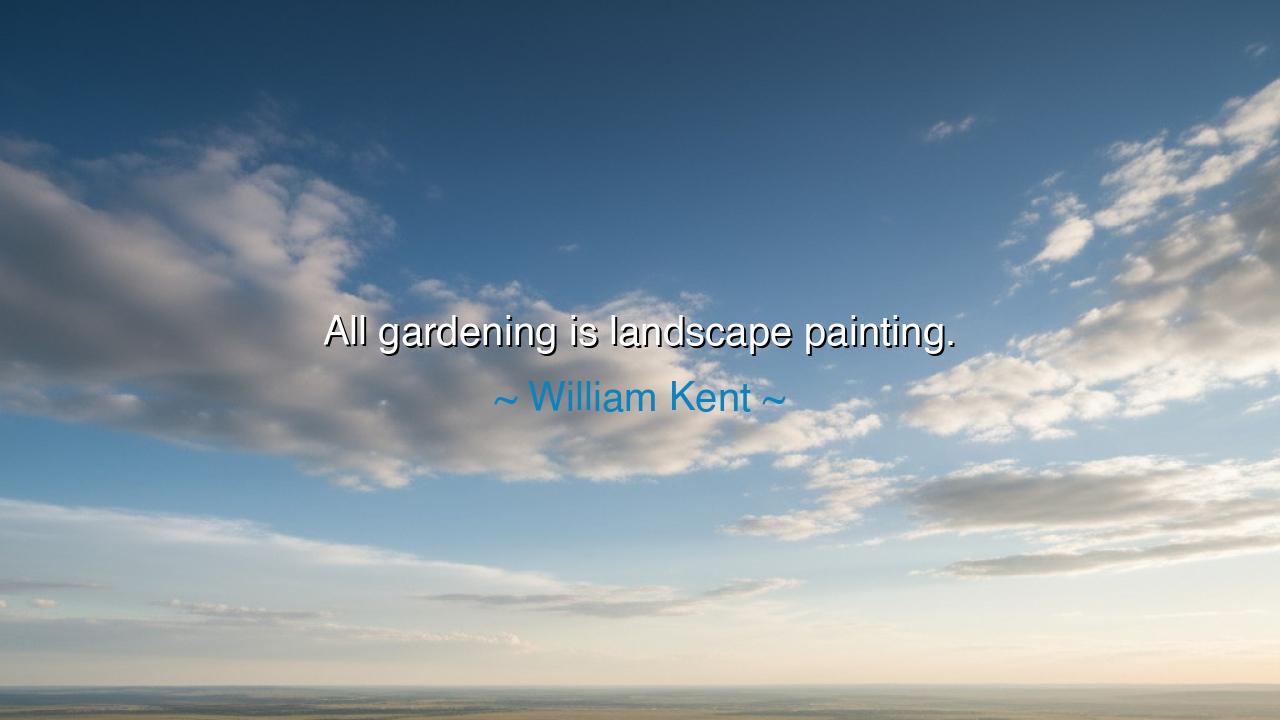
All gardening is landscape painting.






In the quiet space where nature and creativity meet, there is a profound truth that many have known but few have fully grasped. William Kent’s declaration, "All gardening is landscape painting," speaks to the essence of the act of cultivating the earth. Gardening is not merely the task of planting seeds or tending to the soil—it is, in its deepest form, an act of artistry. To the gardener, the earth is the canvas, and the plants, stones, trees, and flowers are the brushstrokes that create a living, breathing masterpiece. Every garden, no matter how humble, is an expression of the gardener’s vision, a testament to the relationship between the human soul and the natural world. The garden becomes a reflection of the gardener's heart, much like a painting captures the soul of the artist.
In the ancient world, the act of creating beauty through nature was held in the highest regard. The Romans, for example, cultivated magnificent gardens not only for the purposes of pleasure and relaxation but as places of reflection, meditation, and spiritual renewal. The gardens were meticulously designed, with each plant and path placed with purpose and intention. The renowned Roman statesman and philosopher Cicero often wrote about the significance of gardens as spaces where the mind could find peace, free from the turbulence of public life. The garden was not just a plot of land—it was a space for the soul to wander, to contemplate, and to connect with the divine. Just as Kent saw gardening as landscape painting, the ancients understood the act of tending to the earth as an act of creating a living, evolving work of art.
Likewise, in ancient China, gardens were seen as microcosms of the universe. The famed Chinese scholar-officials often spent time in their gardens, not merely for leisure but to cultivate an environment that embodied the harmony and balance of the natural world. The design of the garden, much like a work of art, was infused with symbolism and meaning. Every stone, every plant, and every curve of the pathway reflected the principles of Taoism—the harmonious balance between yin and yang, the forces of nature that govern the universe. The garden, for the Chinese, was not only a place of beauty but a space where the human spirit could reconnect with the cosmic order. Gardening, in this sense, was a form of landscape painting—a way to express the unseen forces that shape life itself.
The notion that gardening is landscape painting can also be traced to the Renaissance period, when the boundaries between art and nature were blurred. The great artist Leonardo da Vinci was not only a painter and sculptor but also a naturalist, studying plants, animals, and the rhythms of the earth with the same intensity he applied to his artwork. His meticulous drawings of plant life and landscapes were not merely representations of nature—they were an attempt to understand the form and movement that governed life itself. For da Vinci, the garden was as much a canvas as his sketches, and his work reflected a deep belief that nature, in all its complexity, was a perfect example of the divine art of creation. Similarly, Kent’s words remind us that gardening is a visual and sensory art form, where the gardener must understand not only the science of growth but also the language of beauty and composition.
The connection between gardening and landscape painting extends beyond the technicalities of planting and design. To garden is to engage in the process of creation, to bring forth life where there was once only earth. This act of creation is inherently transformative. Take, for instance, the work of Capability Brown, the famous English landscape architect. Brown is credited with transforming the English countryside into a series of breathtaking, sprawling gardens that blurred the lines between the natural world and human design. His gardens were designed to evoke a sense of order and serenity, with sweeping lawns, strategically placed trees, and lakes that appeared to be naturally occurring. Brown’s work was a reflection of his belief that gardens were living paintings, constantly changing with the seasons, the weather, and the gardener’s touch.
Just as the painter dips his brush into colors to create a harmonious scene, the gardener plants and shapes the landscape with an artist’s eye, arranging the plants to create a living tapestry. The lesson in Kent’s words is one of vision and creation. When we engage with nature, whether through gardening or other forms of artistic expression, we are not merely interacting with the physical world. We are participating in the creation of something meaningful, something that speaks to the soul and connects us to the larger universe. The garden, like the painting, is a reflection of the human spirit’s desire to express, to create, and to find beauty in the world.
In our own lives, we are called to approach life’s work with the same artistry and intention. Whether we are cultivating a garden, building relationships, or shaping our careers, we must remember that we are always creating, always painting a landscape with our actions, words, and intentions. Let us be mindful of the beauty we create, knowing that every gesture, like every brushstroke, leaves a lasting impression. We must learn to see the world as a canvas, a space where we can actively engage with nature and humanity to create something of meaning, purpose, and beauty. Just as a garden is a landscape painting in itself, so too is our life—a living artwork that we have the power to shape, one action at a time.






AAdministratorAdministrator
Welcome, honored guests. Please leave a comment, we will respond soon